2019年新版必修一Unit3 Sports and fitness 教案2(语法与写作)
- 格式:docx
- 大小:54.19 KB
- 文档页数:18
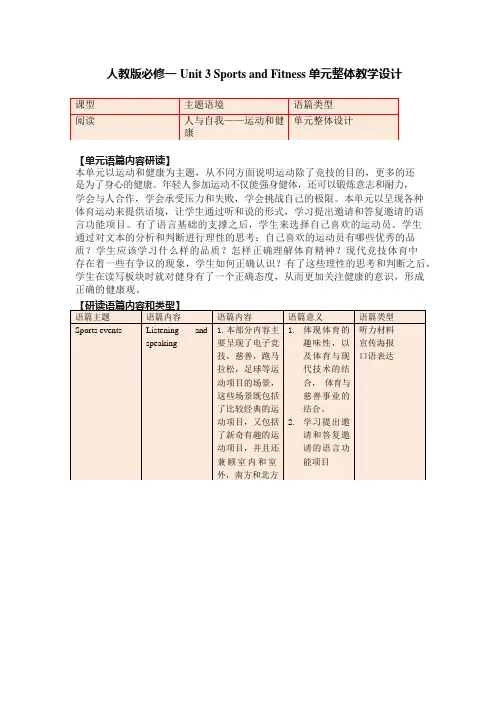
人教版必修一Unit 3 Sports and Fitness 单元整体教学设计【单元语篇内容研读】本单元以运动和健康为主题,从不同方面说明运动除了竞技的目的,更多的还是为了身心的健康。
年轻人参加运动不仅能强身健体,还可以锻炼意志和耐力,学会与人合作,学会承受压力和失败,学会挑战自己的极限。
本单元以呈现各种体育运动来提供语境,让学生通过听和说的形式,学习提出邀请和答复邀请的语言功能项目。
有了语言基础的支撑之后,学生来选择自己喜欢的运动员。
学生通过对文本的分析和判断进行理性的思考:自己喜欢的运动员有哪些优秀的品质?学生应该学习什么样的品质?怎样正确理解体育精神?现代竞技体育中存在着一些有争议的现象,学生如何正确认识?有了这些理性的思考和判断之后,学生在读写板块时就对健身有了一个正确态度,从而更加关注健康的意识,形成正确的健康观。
单元总目标:通过本单元学习,学生能够:1.正确使用关于运动和运动员的相关单词和词块进行口语表达和写作训练,能够正确并理解运用附加疑问句。
阅读杂志文章,提取主要的信息和观点,并形成个人见解;阅读高中学生的健身随笔,学习比较异同的写作方法,能够就运动员的表现和体育精神表达同意和不同意的观点;能够能够写一篇描述自己在健身方面今昔对比比的小语篇。
2.能够在听力训练中抓住主旨大意,能够利用图片和标题预测杂志文章的内容。
3.了解世界各地的特色体育项目,著名运动员和大型体育赛事,形成正确的健身意识和习惯,理解体育精神和公平竟争的深刻含义。
4.对阅读与语篇中各信息之间的逻辑关系进行分析与推断,归纳作者的观点及其论据,对有关体育精神的说法和事例进行理性分析和判断,能表达理由并形成个人见解。
【单元整体教学设计】。
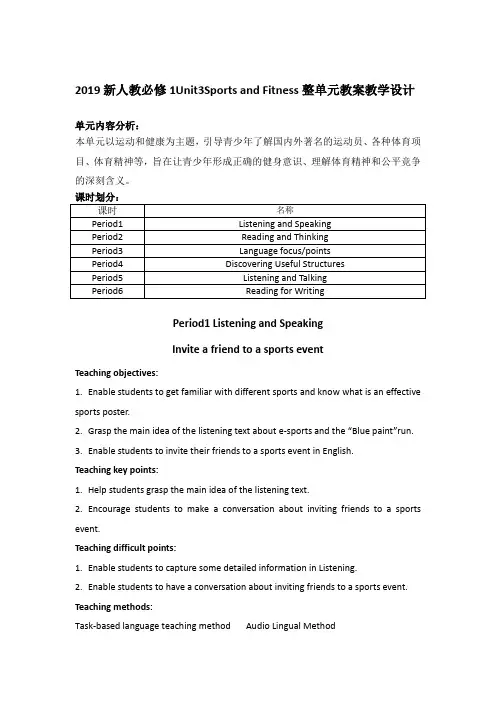
2019新人教必修1Unit3Sports and Fitness整单元教案教学设计单元内容分析:本单元以运动和健康为主题,引导青少年了解国内外著名的运动员、各种体育项目、体育精神等,旨在让青少年形成正确的健身意识、理解体育精神和公平竞争的深刻含义。
Period1 Listening and SpeakingInvite a friend to a sports eventTeaching objectives:1.Enable students to get familiar with different sports and know what is an effective sports poster.2.Grasp the main idea of the listening text about e-sports and the “Blue paint”run.3.Enable students to invite their friends to a sports event in English.Teaching key points:1.Help students grasp the main idea of the listening text.2.Encourage students to make a conversation about inviting friends to a sports event.Teaching difficult points:1.Enable students to capture some detailed information in Listening.2.Enable students to have a conversation about inviting friends to a sports event. Teaching methods:Task-based language teaching method Audio Lingual MethodCommunicative ApproachTeaching procedures:Step1 Lead-inLook at the pictures on P36 and discuss.T:Boys and girls, what can you see from the picture?S1:I can see a young woman running to a hill. She is wearing light clothes to keep her cool and special shoes to help her move better and comfortably.T: Can you predict what the topic of this unit is?S2: The topic of this unit is sports and fitness.Step2:Listening:Invite a friend to a sports eventActivity1:Warming upLook at the posters on Page36 and answer the questions.T:What sports events do you like to watch?(students’ answers are various: swimming, volleyball, basketball, long jump, jogging)T: Which poster is the most effective?S: The first poster is the most effective, because it tells us more detailed information, such as the time, the place of the game and something about tickets that are on sale. Activity2:Listen to Conversation11.After listening, finish Ex2 on page36 and find out Shen Qi’s main purpose for talking to Amy. (answer: to invite Amy to an e-sports event)2.Listen to Conversation 1 again and find out more details.(or do Ex3 on page36)Shen: E-sports are sports you play with a computer, like computer games.Amy: Those aren’t real sports, are they?Shen: Yes, they are. Many people play and watch e-sports. I have been waiting for this event for a long time.Would you like to come along?Amy:Really? I’d love to! Where is it?Shen: It’s in the new stadium. Why don’t you join us this Saturday afternoon? Activity 3:Listen to Conversation 2Listen to conversation 2 and fill in the tableStep3:SpeakingActivity1: According to the posters and Conversation1, sort out the sentence patterns to invite others.Sentence patterns: What/How about...?Why don’t you...? Would you like to...? Do you want to... Why not?Activity2:Work in pairs. Make a conversation--invite your friend to an event.Step4: Homework1.Write down the conversation you made in class about inviting your friend to an event.2.Write a text to describe the “Blue Paint”run to your friend.Period2 Reading and ThinkingChoose your favourite athleteTeaching objectives:1.Students will be able to learn about famous athletes at home and abroad--Lang Ping and Michael Jordan.2.Figure out the reasons why Lang Ping and Michael Jordan are living legends.3.Master the structures and language features of the text and the usage of words and phrases describing the qualities of outstanding athletes.Teaching key points:1.Guide students to better understand the great achievements and good qualities of Lang Ping and Michael Jordan.2.Enable students to identify the structures and language features of the text. Teaching difficult points:1.Enable students to summarize the good qualities of Lang Ping and Michael Jordan.2.Help students grasp and use some words and phrases describing the qualities of outstanding athletes.3.Guide students to explore the language features of the text.Teaching methodsTask-based language teaching Communicative ApproachTeaching procedures:Step1 Lead-inShow students some pictures about some famous athletes in China and ask students to describe them.Step 2 Predicting for possible information.T: Boys and girls, please look at the pictures on Page 38 and the title,judge the type of writing of the text and tell me what the text is about.S1:The type of writing of the text is a magazine article---help us choose some living legends of sports.S2: The pictures show people doing various sports so we can predict that the text is about sports. The title is “Living Legends”, so it may be concerning great sportsmen who are living today.Step3 Skimming for main ideasActivity1:Structure Analysis (结构分析)Read the whole text quickly,divide the text into three parts ,summarize the main idea of each part and then fill in the table.(红色为学生填写内容)Step4 Scanning for details and summarize the heroes’ good qualities.Activity1 read the part of Lang Ping, answer the following questions and draw a mind map or a table to show your answers.T: Is Lang Ping a master in her sports? And what good qualities does she have?S:students’ answers are various.Activity2 Read the part of Michael Jordan, answer the following questions and also draw a mind map or table to show your answers.T:Is Michael Jordan a master in her sports? If so, please give some supporting details. And what good qualities does he have?Step5 Reading for language featuresRead the text once again and find out the sentences where figures of speech are used.Suggested answers:1.As a player,Lang Ping brought honour and glory to her country. As a coach,she led the China women's volley-ball team to medals at world championships and the Olympics. As a person,Lang Ping is loved by fans at home and abroad.(parallelism 排比)2.When Michael Jordan's feet left the ground,time seemed to stand still.(personification 拟人)3.“I can accept failure; everyone fails at something. But I can't accept not trying.”(quotation引用)Step 6 Thinking and SharingT: Apart from the two living legends mentioned in the passage, who would you choose as another living legend?The following expressions can help you.Example:My favourite athlete is Yao Ming. He is widely considered the greatest basketball player in China. He grew up in Shanghai and his skill and determination led him to play for our country and brought honour and glory to our country. After stopping playing,he has been playing an important role in promoting sports and protecting the wildlife.Step7 Homework1.Review what we have learnt in class.2.Write a short passage of your living legend.3.Search more information about the living legends in sports on the Internet.Period3 Language focus/pointsTeaching objectives:1.Enable students to master the usage of such important words and expressions as master,honour,determination,fall apart,injure, lose heart,stand still,strength,fail,give up etc;learn to express themselves by using them.2.Enable students to grasp the usage of important sentence patterns.Learn the method of constructing knowledge trees through self-study and cooperative exploration.3.enjoy the fun of expressing themselves using English and participate in class with passion.Teaching key points:1.Help students to learn the following words and expressions: honour, determination, fall apart, injure, lose heart, stand still, strength, fail, give up etc2.Exercises are designed to assist students to express themselves freely in English. Teaching difficult points:How to use the words , phrases and sentence patterns in real situations.Teaching methods:Task-based language teaching Communicative ApproachTeaching procedures:Step 1:Self-study timeLearn the following words and expressions...by themselves according to the work sheets.Step2:Focus on language(红色部分为学生作答部分)1.【教材原句】They must be athletes who are masters in their sports and also set good examples for others.他们必须是所在运动项目上的大师,并且是他人学习的楷模。
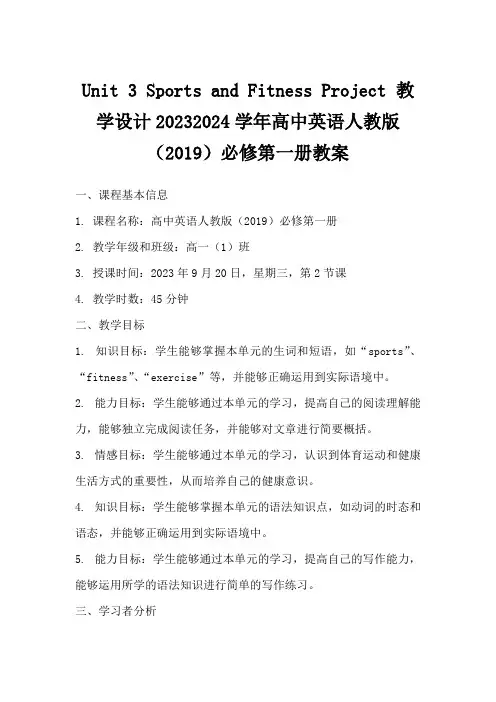
Unit 3 Sports and Fitness Project 教学设计20232024学年高中英语人教版(2019)必修第一册教案一、课程基本信息1. 课程名称:高中英语人教版(2019)必修第一册2. 教学年级和班级:高一(1)班3. 授课时间:2023年9月20日,星期三,第2节课4. 教学时数:45分钟二、教学目标1. 知识目标:学生能够掌握本单元的生词和短语,如“sports”、“fitness”、“exercise”等,并能够正确运用到实际语境中。
2. 能力目标:学生能够通过本单元的学习,提高自己的阅读理解能力,能够独立完成阅读任务,并能够对文章进行简要概括。
3. 情感目标:学生能够通过本单元的学习,认识到体育运动和健康生活方式的重要性,从而培养自己的健康意识。
4. 知识目标:学生能够掌握本单元的语法知识点,如动词的时态和语态,并能够正确运用到实际语境中。
5. 能力目标:学生能够通过本单元的学习,提高自己的写作能力,能够运用所学的语法知识进行简单的写作练习。
三、学习者分析1. 学生已经掌握了哪些相关知识:学生已经学习了英语基础知识,包括语法、词汇和句型等。
他们能够进行简单的英语交流,并能够阅读和理解简单的英语文章。
2. 学生的学习兴趣、能力和学习风格:学生的学习兴趣各异,有的对英语口语感兴趣,有的对英语阅读感兴趣。
他们的学习能力也有所不同,有的学生学习能力强,能够快速掌握新知识,有的学生学习能力较弱,需要更多的时间和帮助来掌握新知识。
学生的学习风格也有所不同,有的学生喜欢通过听觉学习,有的学生喜欢通过视觉学习,有的学生喜欢通过动手操作学习。
3. 学生可能遇到的困难和挑战:学生在学习英语时可能会遇到一些困难和挑战。
例如,他们可能会遇到不认识的单词或短语,不知道如何正确使用语法结构,或者不理解文章的意思。
此外,他们还可能会遇到一些发音和语调的问题,不知道如何正确表达自己的意思。
这些困难和挑战可能会影响他们的学习效果,需要教师给予适当的帮助和指导。
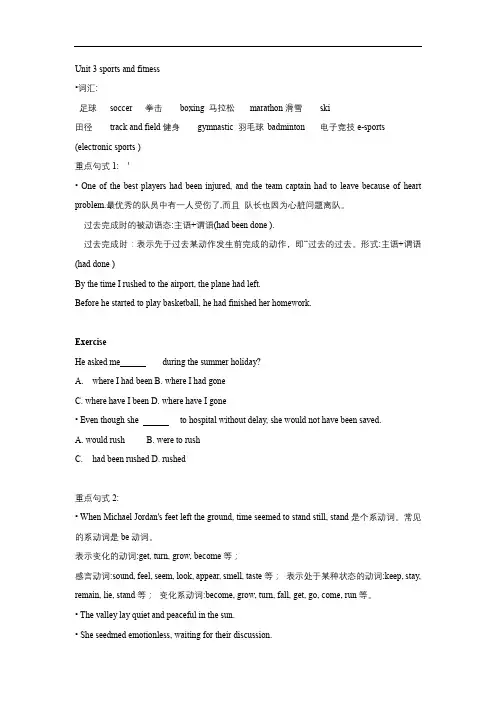
Unit 3 sports and fitness•词汇:足球soccer拳击boxing 马拉松marathon滑雪ski田径track and field健身gymnastic 羽毛球badminton电子竞技e-sports (electronic sports )重点句式1:'• One of the best players had been injured, and the team captain had to leave because of heart problem.最优秀的队员中有一人受伤了,而且队长也因为心脏问题离队。
过去完成时的被动语态:主语+谓语(had been done ).过去完成时:表示先于过去某动作发生前完成的动作,即“过去的过去。
形式:主语+谓语(had done )By the time I rushed to the airport, the plane had left.Before he started to play basketball, he had finished her homework.ExerciseHe asked me during the summer holiday?A.where I had beenB. where I had goneC. where have I beenD. where have I gone• Even though she to hospital without delay, she would not have been saved.A. would rushB. were to rushC.had been rushedD. rushed重点句式2:• When Michael Jordan's feet left the ground, time seemed to stand still, stand是个系动词。
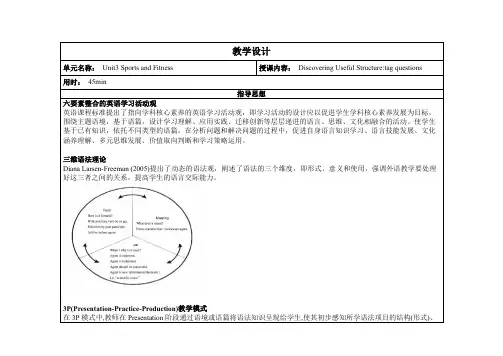
指导思想六要素整合的英语学习活动观英语课程标准提出了指向学科核心素养的英语学习活动观,即学习活动的设计应以促进学生学科核心素养发展为目标,围绕主题语境,基于语篇,设计学习理解、应用实践、迁移创新等层层递进的语言、思维、文化相融合的活动。
使学生基于已有知识,依托不同类型的语篇,在分析问题和解决问题的过程中,促进自身语言知识学习、语言技能发展、文化涵养理解、多元思维发展、价值取向判断和学习策略运用。
三维语法理论Diana Larsen-Freeman (2005)提出了动态的语法观,阐述了语法的三个维度,即形式、意义和使用,强调外语教学要处理好这三者之间的关系,提高学生的语言交际能力。
3P(Presentation-Practice-Production)教学模式在3P模式中,教师在Presentation阶段通过语境或语篇将语法知识呈现给学生,使其初步感知所学语法项目的结构(形式)、the tag question represents something that is unsure. Listen and Underline(5min)T asks Ss to listen to the conversation and underline the tag questions.Discovering the meaning(3min)a negative tag question(changes of predicate verb). Practice①Think and match(5 min)T shows some examples of tag questions to Ss, then asks Ss to match them correctly :After that, Ss complete another three sentences and think about how to form a tag question:1)There is a basketball game at our school this Saturday,?2)You won’t be coming from home,?3)I’ve never said no to food, ?Practice②(5min)Practice③(5 min)T asks Ss to complete the senteces from exercise 2 in textbook.Ss check the answers with their partners at first, then wait for the teacher to show the correct answer. Work in pairs(10 min)。
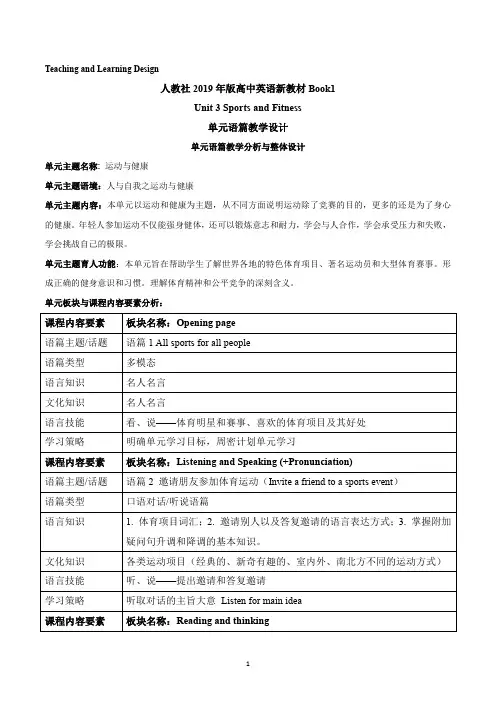
Teaching and Learning Design人教社2019年版高中英语新教材Book1Unit 3 Sports and Fitness单元语篇教学设计单元语篇教学分析与整体设计单元主题名称: 运动与健康单元主题语境:人与自我之运动与健康单元主题内容:本单元以运动和健康为主题,从不同方面说明运动除了竞赛的目的,更多的还是为了身心的健康。
年轻人参加运动不仅能强身健体,还可以锻炼意志和耐力,学会与人合作,学会承受压力和失败,学会挑战自己的极限。
单元主题育人功能:本单元旨在帮助学生了解世界各地的特色体育项目、著名运动员和大型体育赛事。
形成正确的健身意识和习惯。
理解体育精神和公平竞争的深刻含义。
单元板块与课程内容要素分析:课程内容要素板块名称:Opening page语篇主题/话题语篇1 All sports for all people语篇类型多模态语言知识名人名言文化知识名人名言语言技能看、说——体育明星和赛事、喜欢的体育项目及其好处学习策略明确单元学习目标,周密计划单元学习课程内容要素板块名称:Listening and Speaking (+Pronunciation)语篇主题/话题语篇2 邀请朋友参加体育运动(Invite a friend to a sports event)语篇类型口语对话/听说语篇语言知识 1. 体育项目词汇;2. 邀请别人以及答复邀请的语言表达方式;3. 掌握附加疑问句升调和降调的基本知识。
文化知识各类运动项目(经典的、新奇有趣的、室内外、南北方不同的运动方式)语言技能听、说——提出邀请和答复邀请学习策略听取对话的主旨大意Listen for main idea课程内容要素板块名称:Reading and thinking语篇主题/话题语篇3 选择你最喜欢的运动员(Choose your favorite athlete)语篇类型杂志文章之人物传记语言知识 1.与体育运动相关的词汇;2. 就运动员的表现和体育精神表达同意或不同意的观点;3.阅读杂志文章,提取主要信息和观点,形成个人见解4.杂志文章语篇文本结构。
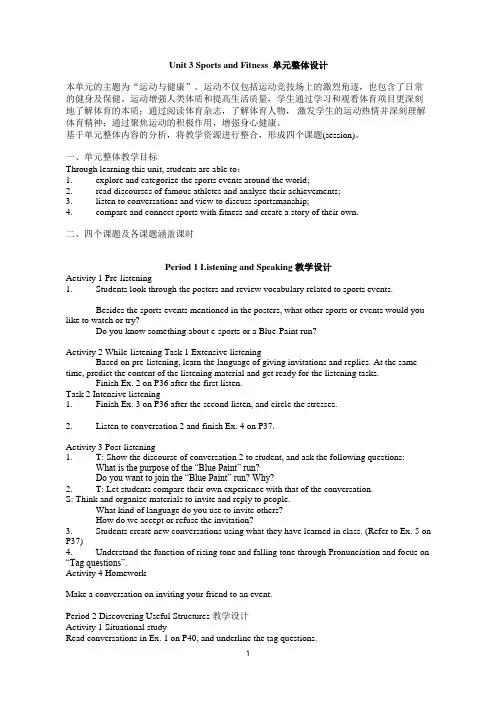
Unit 3 Sports and Fitness 单元整体设计本单元的主题为“运动与健康”。
运动不仅包括运动竞技场上的激烈角逐,也包含了日常的健身及保健。
运动增强人类体质和提高生活质量,学生通过学习和观看体育项目更深刻地了解体育的本质;通过阅读体育杂志,了解体育人物,激发学生的运动热情并深刻理解体育精神;通过聚焦运动的积极作用,增强身心健康。
基于单元整体内容的分析,将教学资源进行整合,形成四个课题(session)。
一、单元整体教学目标Through learning this unit, students are able to:1. explore and categorize the sports events around the world;2. read discourses of famous athletes and analyse their achievements;3. listen to conversations and view to discuss sportsmanship;4. compare and connect sports with fitness and create a story of their own.二、四个课题及各课题涵盖课时Period 1 Listening and Speaking 教学设计Activity 1 Pre-listening1. Students look through the posters and review vocabulary related to sports events.Besides the sports events mentioned in the posters, what other sports or events would you like to watch or try?Do you know something about e-sports or a Blue-Paint run?Activity 2 While-listening Task 1 Extensive listeningBased on pre-listening, learn the language of giving invitations and replies. At the same time, predict the content of the listening material and get ready for the listening tasks.Finish Ex. 2 on P36 after the first listen.Task 2 Intensive listening1. Finish Ex. 3 on P36 after the second listen, and circle the stresses.2. Listen to conversation 2 and finish Ex. 4 on P37.Activity 3 Post-listening1. T: Show the discourse of conversation 2 to student, and ask the following questions:What is the purpose of the “Blue Paint” run?Do you want to join the “Blue Paint” run? Why?2. T: Let students compare their own experience with that of the conversation.S: Think and organize materials to invite and reply to people.What kind of language do you use to invite others?How do we accept or refuse the invitation?3. Students create new conversations using what they have learned in class. (Refer to Ex. 5 on P37)4. Understand the function of rising tone and falling tone through Pronunciation and focus on “Tag questions”.Activity 4 HomeworkMake a conversation on inviting your friend to an event.Period 2 Discovering Useful Structures 教学设计Activity 1 Situational studyRead conversations in Ex. 1 on P40, and underline the tag questions.Activity 2 Rules to followThrough finishing Ex. 1, conclude some rules of “Tag questions”.Activity 3 Practice makes perfectFinish Ex. 2 on P40.Activity 4 Homework1. Finish more exercises (Exx. 2&3 on P85) to consolidate the rules.2. Organize notes on the notebook.Period 3 Expanding Your World 教学设计Activity 1 Lead inT: Ask students a question:What does “hot tickets” mean?S: Have a discussion and check by fast reading.Activity 2 Standards of a hot sport1. a sport with exciting action2. athletes competing to win honor and glory3. history and tradition4. delicious snacksActivity 3 Read and checkT: Are the 3 sports in the article hot sports? S: Voice their opinions and state the reasons. Activity 4 Expanding the worldPlay some videos to broaden the horizons of students.Period 4 Reading and Thinking 教学设计Activity 1 BrainstormStudents discuss their favorite sports and sports stars.Activity 2 Read to predictPredict the text type and content of the text by viewing the pictures, titles, subtitles and format. Activity 3 Read to find Task 1:Extensive readingRead fast, check the prediction and sort out information.Task 2:Intensive readingActivity 4 Read to think Task 1:DiscussionFinish Ex. 2 on P39 identify the meaning of “S、I、E” and make judgement. Check their judgement through the discourse.Group discussion:Conclude the common characters of the two living legends and reflect on students themselves. Task 2:Language appreciationUnderline sentences with rhetoric devices and reflect the function of them in the language use, for example, parallelism.Activity 5 Homework1. Introduce one sports living legend in your eyes, following the example of the passage within 80 words.2. Conclude features of magazine articles.Period 5 Listening and Talking 教学设计Activity 1 Pre-listening1. Discuss the meaning of sportsmanship. (Sportsmanship is behavior and attitudes that show2. Predict the content in Ex. 1 of listening.Activity 2 Understanding the conversation(1) Listen and finish Ex.1,and state their own opinions.(2) Listen for the second time and finish conversation 2, expressing agreement and disagreement.(3) Work in groups and talk around one of the topics in Ex. 3 and share opinions. Time permitting, create the following form.Activity 3 Make conversationsStudents make their own conversations based on their discussion and one of the members make notes.Activity 4 HomeworkWrite the conversation of each group on the notebook.Period 6 Reading and Writing 教学设计Activity 1 MatchMatch the cool cold sports with their descriptions.Activity 2 Fast readingRead to find answers to the following 2 questions:• 1. What is the “summer sibling” of the Winter Olympics?• 2. How does the writer describe figure skaters?Activity 3 Introduce some ice gamesMaterials include: reading passages, videos and “Video Time” can also be included.Activity 4 Broaden horizonsIntroduce some X-sports.Period 7 Reading for Writing 教学设计主题语境:人与自我,人与社会(主题是“为健康簿编写一页内容”)语篇类型:记叙文授课时长:一课时(45 分钟)一、文本分析该文本是一篇描述主人公健身前后变化的文章,收录在国外高中班级里的健康簿(wellness book)中。
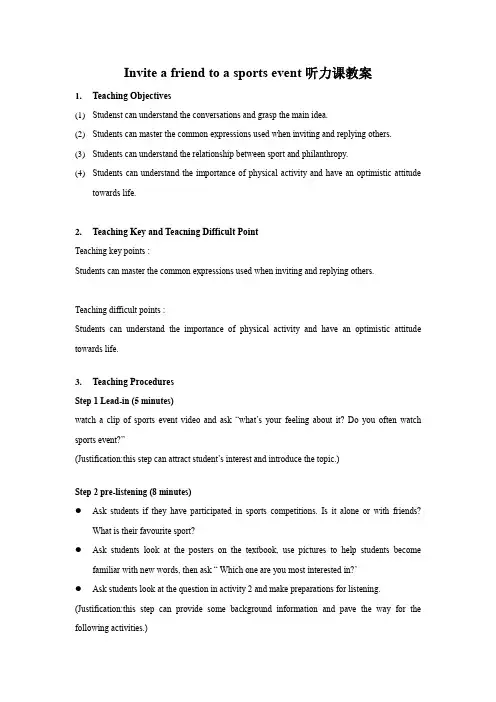
Invite a friend to a sports event听力课教案1.Teaching Objectives(1)Studenst can understand the conversations and grasp the main idea.(2)Students can master the common expressions used when inviting and replying others.(3)Students can understand the relationship between sport and philanthropy.(4)Students can understand the importance of physical activity and have an optimistic attitudetowards life.2.Teaching Key and Teacning Difficult PointTeaching key points :Students can master the common expressions used when inviting and replying others.Teaching difficult points :Students can understand the importance of physical activity and have an optimistic attitude towards life.3.Teaching ProceduresStep 1 Lead-in (5 minutes)watch a clip of sports event video and ask “what’s your feeling about it? Do you often watch sports event?”(Justification:this step can attract student’s interest and introduce the topic.)Step 2 pre-listening (8 minutes)●Ask students if they have participated in sports competitions. Is it alone or with friends?What is their favourite sport?●Ask students look at the posters on the textbook, use pictures to help students becomefamiliar with new words, then ask “ Which one are you most interested in?’●Ask students look at the question in activity 2 and make preparations for listening. (Justification:this step can provide some background information and pave the way for the following activities.)Step 3 while-listening (20 minutes)1)Ask students to listen conversation 1 and find out Shen Qi’s main purpose for talking to Amy.Then check the answer together.2)Summarize some tips to grasp main idea.3)Ask students to listen conversation 1 again and finish activity 3.Then check the answertogether.4)Ask students to listen conversation 2 and finish the questions in activity 4.Then check theanswer together.5)Ask students think about the purpose of “BluePaint” run, and ask do you think this activity isworthwhile? Why? If you were given a chance, would you go for it?(Justification: This step can help students understand the listening material and improve their listening abilities to grasp main idea and detailed information.)Step 4 post-listening(10 minutes)Pair work●Summarize the expression used to invite othersWould you like to.....That would be great.How/What about....All right!Why don’t you....Yes, I’d love to.Could you please.....I’m sorry./I’m afraid I can’tI’d like to invite you to.....I’d like to, but......●Look at the three sports event in activity 5, which one would you like to invite your friends to?Make a conversation used what we have learnt today.(Justification: This step can help students consolidate what they have learned and help students to apply the new knowledge to other situation.)4.Homework (2 minutes)Invite your friends to watch sports with you.。
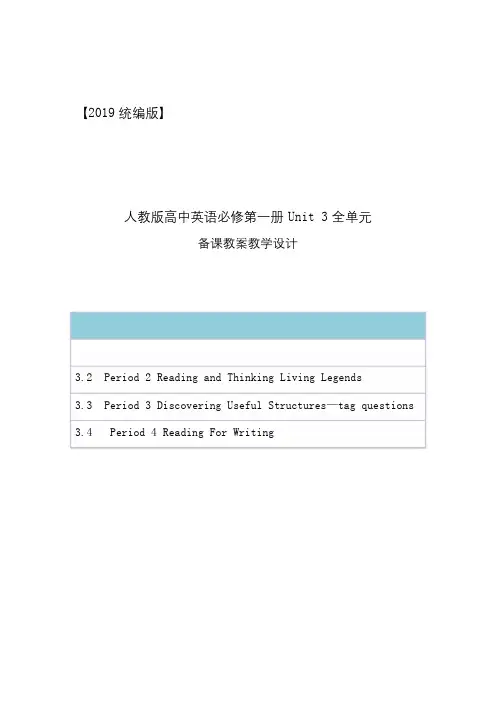
【2019 统编版】人教版高中英语必修第一册Unit 3 全单元备课教案教学设计3.2 Period 2 Reading and Thinking Living Legends3.3 Period 3 Discovering Useful Structures—tag questions 3.4 Period 4 Reading For WritingPeriod 1 Listening Speaking &Talking教学目标与核心素养:1. Instruct students to get main facts by listening and motivate themto talk about the topics about how to invite a friend to a sports event,voice one’s own opinions about sportsmanship by listening.2. Develop students’ sense of cooperative learning and individual thinking capability.3. Develop students’ different listening skills to solve different listening comprehensive problems.教学重难点:1. Teach students how to focus on key words, not on single words or grammar.2. Prompt Ss to talk about the related topics, such as how to invitea friend to a sports event and voice one’s own opinions about sportsmanship.教学过程:Part 1: Listening and SpeakingLead inThe teacher is advised to talk with their students about sports events.Boys and girls, look at the posters on p36, what sports events do you like to watch? Which sports would you like to try? After their small talk, the teacher can move on by finishing the following listening task: Play conversation 1 which is about Shen Qi’s main purpose for talkingto Amy and after finishing listening for the first time, the students needto solve the following tasks.1.Purpose_________________________________________________________________________________________________________________2. Listen to conversation 1 again and write down the words that thespeaker stresses:_________________________________________________________________ _____________________________________________________________________ ___Listening tip:Listen for main ideas.Try to catch the main ideas instead of trying to remember and translate each word you hear.After finishing the task above, the teacher is expected to play conversation 2 which is about Adam’s inviting Julie to a sports event and after finishing listening, the students need to solve the following task.Listen to Conversation 2. Then answer the following questions:1. When will the event happen?The event will happen____________________________________2. What's a "Blue Paint" run?A "Blue Paint run is a fun run that- flled ________________________________________________3. Why is it called a "Blue Paint" run?Because people can buy water ballons with_________________and_______________the runners.4. If 200 people take part in the run and 400 balloons are sold, how much money will they collect?_____________________________________________________________________ __________Finally, after finishing the task above, the teacher is expected to instruct students to work in groups to finish the following project: Speaking ProjectWhat event or activity would you like to invite your friend to? Makea conversation with a partner.Ski Race: Zhangjiakou, a beautiful city in northern China, will host the Youth Ski Race in December.Track Meet: a great event for track –and –field lovers on 26 October.Gym Class: come and work out at a gym! You can make it.Part 2: Listening and Talking:The teacher is advised to talk with their new students about the related topic:Boys and girls , what do you think of sportsmanship? Let’s listen and find out:Play the listening and match each opinion with the right speaker. Who do you agree with? Why?Cao Jing ________________Lily_____________________Max________________A. An athlete should do his/her best to win.B. The girl should stop and help the other girl. Good sportsmanship is more important than wining!C. An athlete should think about honorand his/her fans if he/she is competing for his/her country.Listen again and circle the expressions that you hear in the conversation.disagreeingI'm sorry, but I disagree/don'tagree.All rightGood idea. Yes, I think so. That doesn't make any sense! That's not how I see it.I see what you mean, but …Sure./Certainly./Of course. You're right/correct.I guess so.Talking projectWork in groups. Choose one of the situations below and make a conversation: ●A soccer player should not pretend to fall down even if it helps his/her team.●In school teams, everyone should get a chance to play, not only the best players.●It is wrong to pay people millions of yuan to play sports.●Athletes should play only for their own country.EXAMPLEA: I agree with the idea that a soccer player should never pretend to fall down even if it helps his or her team. You should never cheat.B: Exactly! It's important to do the right thing.C: Well, | don't think so. Many players do it, and they think it helps their team to win.A: That doesn't make any sense!B: I see what you mean, but the audience wants fair play.Period 2 Reading and ThinkingLiving Legends教学目标与核心素养:1. Read quickly to get basic information about Lang Ping and Jordan; read deeply to understand why they can be called sports legends.2. Understand the meaning of some languages in the context of the text through question guidance, such as "time seems to stand still, graceful" and so on.3. Read and clarify the context of each part of the text, learning how to talk and write sports legends.4. Through comparative analysis, we can form the criteria for judging the legendary figures and learn to choose the legendary sports stars we like.教学重难点:1. Get basic information about Lang Ping and Jordan; read deeply2. Understand why they can be called sports legends.3. Understand the meaning of some languages in the context of thetext, such as "time seems to stand still, graceful" and so on.教学过程:1. Warming upStep 1 Leading-inQ2: Do you like him/her? Why?Q1: What do you know about Lang Ping and Michael Jordan?Q2: What else do you want to know about them?Step 2: Reading to get related information about the two sports star1. Read quickly to answer students’ own questions and the following questions.Q1: What contributions did Lang Ping make in volleyball?Q2: What contributions did Michael Jordan make in basketball?Q3: What’s special about Michael Jordan in his life?2. Discuss answers and deal with some new words.Step 3 Understanding the title and the lead paragraphAnswer the following questions.Q1: Why do you think the author chooses to write these two sports stars? Q2: What does “living legend” mean?Q3: What are the standards or requirements to be chosen as a living legend of sports star?Step 4 Getting detailed information about Lang Ping1. Read to answer the following questions.Q1: Is Lang Ping a master in her area? How do you know that?Q2: What good examples does Lang Ping set for others?2. Focus on the story about Lang Ping.Q1: Lang Ping’s determination was tested. What happened to her?Q2: Was the challenge big? How do you know?Q3: Did she give up?Q5: What can we learn about Lang Ping from the sentence “She had met difficulties before.” mean?Q6: What can we learn about Lang Ping from the sentence “She knew her young player could win if they worked together as a team.”?4. Sum up the information about Lang Ping with the tableGreat determinationand courageAs aQ: Why is Lang Ping a living legend of sports?Step 5: Exploring detailed information about Michael Jordan1. Read the paragraph of Michael Jordan and complete the following table. We have got to know why Lang Ping is a living legend. Now read and find out why Michael Jordan is a living legend on your own by completing the following table.Living legends Jordan Masters?Good examples?Q: Which part is about Michael Jordan as a master? Which part is about the example he set?(2) Focus on why Michael Jordan is a master.Q1: How does the author describe his impressive skills?Q2: How do you understand “time seemed to stand still”?Q3: What does “graceful” mean?(3) Focus on what good examples Michael Jordan set.Q4. Which sentence do you think best describes his mental strength?Q5. Which words is important in the sentence in describing his mental strength? Why?Q6: How do you understand “unique”?Q7: What can we learn from Michael Jordan?Work in groups to choose your own living legend of sports and give the reasons of your choice.Period 3 Discovering UsefulStructures—tag questions教学目标与核心素养:1. Get students to have a good understanding of the basic usages of tag questions.2. Enable students to use the basic phrases structures flexibly.3. Develop students’ speaking and cooperating abilities.4. Strengthen students’ great interest in grammar learning.教学重难点:1. How to enable students to have a good understanding of the basic usages of tag questions.2. How to enable students to use the basic usages of tag questions flexibly.教学过程:Step1: 语法自主探究(一)基本组成方法1. 肯定式陈述You often play badminton, don’t you? 你经常打羽毛球,部分+否定附加是吗?She’s been to shanghai before, hasn’t she? 她以前去过上海,是吗?2. 否定式陈述It isn't a beautiful flower, is it? 那不是美丽的花,是部分+肯定附加吗?疑问部分(前否You didn't go skating yesterday, did you? 你昨天没去滑They can’t finish it by Friday, can they?他们不能在星期五之前完成,是吗?3. 含有否定词(1)当陈述句中含有He hardly goes to school by car, 的附加疑问句seldom, hardly, never, does he?rarely, little, few, 他几乎不开车去上学,是吗?none, neither ,no, not, You have never been to Paris,nowhere, nothing no one, have you?nobody 等否定意义的词你从没去过巴黎,是吗?时,后面的附加疑问句则为They seldom come late, do they?Little has been done to preventpollution, has it? 几乎没有做什么来防止污染,是吗?(2)如果陈述句中仅含否He is unfit for his job, isn’t定前缀的词unhappy, he?dislike, impossible等,他不适合这项工作,是吗?则后面的附加疑问句仍为It is impossible, isn't it? 那He dislikes his classmates,doesn’t he?他不喜欢他的同学,是吗?4. 祈使句的附(1)肯定的祈使句的附加Come along with me, will you /疑问句在句末加“w i l l won’t you ?/can you ?/ can’tyou? /won’t you?/can you?(2)否定的祈使句的附加Don't make any noise, will you?疑问句通常在句末加别出声,好吗?“will you?”(1)Let's 开头的祈使句, Let's go and listen to the附加疑问句用shall we? music, shall we?(2)Let us 开头的祈使让我们去听音乐,好吗?句,附加疑问句用 will Let us wait for you in thereading-room, will you? 我们在阅览室等你,好吗?(二)附加疑问句注意几种特殊情况:1. 当陈述部分主语是everyone/ Nobody saw him walk into the room, everybody, someone/somebody, no one/ did they? 没人看见他走进房间,是nobody, none 等表示人的不定代词时,吗?附加疑问句部分的主语多用 they,但也Everything has gone wrong today, 可用he ;当陈述部分的主语是hasn’t it?everything, anything, something, 今天什么都出了问题了,是不是?nothing 等表示物的不定代词时,附加疑问句部分的主语用it。
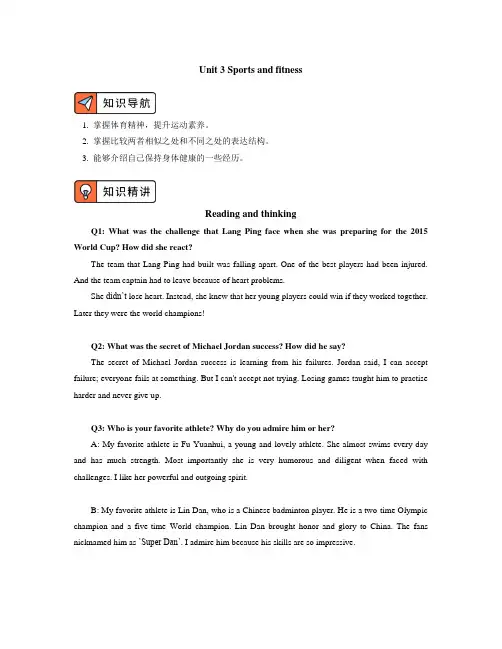
Unit 3 Sports and fitness1. 掌握体育精神,提升运动素养。
2. 掌握比较两者相似之处和不同之处的表达结构。
3. 能够介绍自己保持身体健康的一些经历。
Reading and thinkingQ1: What was the challenge that Lang Ping face when she was preparing for the 2015 World Cup? How did she react?The team that Lang Ping had built was falling apart. One of the best players had been injured. And the team captain had to leave because of heart problems.She didn’t lose heart. Instead, she knew that her young players could win if they worked together. Later they were the world champions!Q2: What was the secret of Michael Jordan success? How did he say?The secret of Michael Jordan success is learning from his failures. Jordan said, I can accept failure; everyone fails at something. But I can't accept not trying. Losing games taught him to practise harder and never give up.Q3: Who is your favorite athlete? Why do you admire him or her?A: My favorite athlete is Fu Yuanhui, a young and lovely athlete. She almost swims every day and has much strength. Most importantly she is very humorous and diligent when faced with challenges. I like her powerful and outgoing spirit.B: My favorite athlete is Lin Dan, who is a Chinese badminton player. He is a two-time Olympic champion and a five-time World champion. Lin Dan brought honor and glory to China. The fans nicknamed him as ’Super Dan’. I admire him because his skills are so impressive.C: I like Ai Fukuhara best. She is a retired Japanese table tennis player, who came to China to receive the training when she was only five years old. Whatever difficulty she met, she never lost heart or gave up. She sets a good example for me.(1) As a player, Lang Ping brought honour and glory to her country.honour n. 荣誉;尊敬;荣幸He brought honour to his family. 他为家庭争了光。
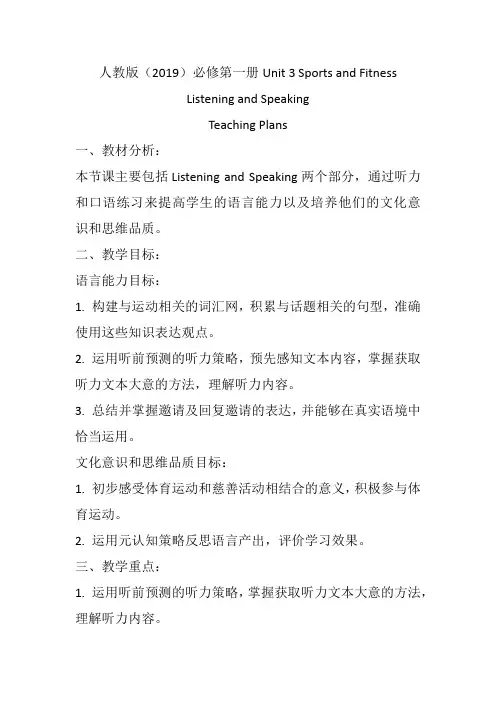
人教版(2019)必修第一册Unit 3 Sports and FitnessListening and SpeakingTeaching Plans一、教材分析:本节课主要包括Listening and Speaking两个部分,通过听力和口语练习来提高学生的语言能力以及培养他们的文化意识和思维品质。
二、教学目标:语言能力目标:1. 构建与运动相关的词汇网,积累与话题相关的句型,准确使用这些知识表达观点。
2. 运用听前预测的听力策略,预先感知文本内容,掌握获取听力文本大意的方法,理解听力内容。
3. 总结并掌握邀请及回复邀请的表达,并能够在真实语境中恰当运用。
文化意识和思维品质目标:1. 初步感受体育运动和慈善活动相结合的意义,积极参与体育运动。
2. 运用元认知策略反思语言产出,评价学习效果。
三、教学重点:1. 运用听前预测的听力策略,掌握获取听力文本大意的方法,理解听力内容。
2. 构建与运动相关的词汇网,准确使用这些知识表达观点。
3. 掌握邀请及回复邀请的表达,并能够在真实语境中恰当运用。
四、教学难点:1. 听力理解能力的培养,尤其是对于新的主题和场景的听力理解。
2. 运用所学的词汇和知识表达观点的能力。
3. 口语表达能力的培养,特别是在约请及回复邀请的情境中。
五、学情分析:学生是高一年级的英语学习者,具备一定的英语基础知识和听说能力。
他们有一定的学习能力和思维品质,但对于体育运动和慈善活动相结合的主题可能较为陌生。
因此,在教学中需要给予他们足够的情境及语言表达的机会,同时培养他们探索和思考的能力。
六、教学策略:1. 设计多样化的任务,激发学生参与学习的兴趣。
2. 借助视觉材料,引发学生的思考和讨论。
3. 引导学生进行交互式的口语练习,培养他们的口语表达能力。
4. 提供反思和评价的机会,引导学生从元认知的角度思考和评价自己的学习效果。
七、教学方法:1. 预测法:在听力前,引导学生根据提示或图片预测即将听到的内容。
ook1 Unit3:Sports and FitnessReading for Writing教学设计课题名称:Write a page in a wellness book课型:读写课一、教学目标1.通过阅读篇章,学生将学习关于如何保持健康的词汇与表达。
2.通过独立思考、小组合作,学生将训练并提高英语的思维和交际能力,以及用英语解决生活中实际问题的能力;3.通过完成写作任务,学生将重新思考健康的含义,形成健康的生活习惯。
二、教学重点1.通过阅读篇章,提炼写作素材;2.通过完成写作任务,形成健康的生活观念。
三、教学难点通过知识的迁移,创造性的完成学习任务。
四、教学过程T: Teacher Ss: StudentsStep I Lead in:T: Ask ss a question: Do you really know how to keep fit?Show ss a picture about themselves when they take running exercise in the early morning. Ask ss to make a conclusion about the benefits of working out in the morning.Ss:Ss have already previewed the article Benefits of working out in the morning and are expected to finish the following chart:One of the students will be invited to summarize the benefits of working out in the morning.T:Ask ss to think about if there are other good suggestions to keep healthy. 设计目的:导入部分以引导学生思考保持健康和进行体育锻炼的好方法方法,产生了信息不对等,真实触发了学生阅读课文的兴趣和动机。
Unit3 Sports and FitnessPeriod 4 Reading For Writing教学设计This teaching period mainly deals with reading for writing a class wellness book. Students are expected to learn the knowledge about how to write a class wellness book. First, students are supposed to read a passage which is specially designed to study for the writing purpose. Then, under the guidance of the teacher, students should discuss the topics mentioned on the textbook and learn to write a proper wellness book. The teacher is expected to enable students to master some writing skills concerning class wellness book and learn to write one.1. Get students to have a good understanding of how to write class wellness book properly.2. Enable students to use some writing skills flexibly.3. Develop students’ writing and cooperating abilities.4. Strengthen students’ great interest in writing discourses.1. How to enable students to have a good understanding of the skills of writing a class wellness book2.How to enable students to write a good class wellness book using some writing skills properly.Step1 Lead in:At the beginning, a teacher can introduce the topic by asking: Do you want to lose weight and why? Do you think you are fit? After having a small discussion about it, they can move on to read the passage and handle the following activities one by one.Step 2: Read to discover detailsStudents are instructed to read a passage titled “Going Positive” and then solve the questions below. 1.What problem did Kayla have in the past?2.What does the sentence“| almost went bananas “mean?3.What made her change her thinking?After completing the activities above, they can move on to the text task:Step 3: Read to sum upRead the passage again and figure out the organization and language features. Title:_______________________________________________The turning point:________________________________________________the past the presentAim: _________________________ __________________________ Mood :__________________________ ______________________ Actions:________________________ ______________________ ______________________ ____________________________________________ ____________________________________________ ______________________ Step 4: Use what you have learnt to write a proper class wellness book.1. Work in groups. Discuss the questions below.ExerciseWhat can you do to make exercise like jogging more enjoyable?StressHow can you plan your work and make sure that you also have time to rest and relax? Self-confidenceWhat can you do to become more confident and feel better about yourself?FoodHow can you make your meals healthier?e the ideas from your discussion to list some positive changes.●What you used to do/do now and results:●What you do now/will do in the futureUseful expressions to show similarities and differences:Write a short paragraph to describe and explain your changes.Step V:1.健康书的审题步骤:第一步:明确要求该写作属于经验分享,故要用第一人称来写;时态以一股现在时为主。
Lesson Plan for“Write a page in a wellness book”Designer Students to Be Taught SenioroneModule / Unit to be taught Unit 3 Sports and Fitness Type of the Lesson WritingMaterials Analysis The teaching content “Write a page in a wellness book” is from the unit 3 SPORT AND FITNESS, Reading for Writing of the book PEP senior high school English compulsory 1.The theme of the Listening and Speaking lesson is “ Invite a friend to a sport event”, which is about describing a sport event and make an invitation. Students will know lots of basic information of some sport event.The theme of Reading and Thinking lesson is “ LIVING LEGENDS”. It’s about the experiences and achievements of Lang Ping and Michael Jordan. Students will learn the excellent qualities of these two successful person.The grammar item of the Discovering Useful Structure lesson is the question and answer of General Question. by learning this section, students will have the ability to apply this grammar item.The Listening and Thinking lesson is “V oice your opinion on sport s manship”, which is about understanding other’s opinion on sport smanship and expressing their own opinions.The theme of the Reading for Writing lesson is “Write a page in a wellness book”. Students will learn the benefit of sports and cultivate the awareness to sports.The contain of the Assessing Your Progress lesson is some exercises of the new words and grammar item in this unit. It can help students to strengthen the knowledge of this unit.The theme of this unit is about sport of the thematic context “Man and Society”.This thematic context includes sports activities, large-scale, sports event, sport and health, sportsmanship.This class mainly involves sport and health which is closely related to students’ life. ThemePersonal experiences or advice on sports.Text typeNarration.Language knowledgeSince the reading material is about two Kayla’s ideas about health and fitness, so the linguist items will be as follows:1.New wordsSlim, diet, rather2.Expressions about healthCultural knowledgeThe awareness of keeping healthy and the different ways to keep healthy between China and other countries.Language skills1.Convey information, expound and prove arguments, and express emotions in written form.2.Relate the content of the text to one’s own life experience.Learning strategies1.List the main information and organize the basic information structure according to the needs of the thematic expression.e appropriate sentences, paragraphs and text structure to enhance the logic of the text.Learner Analysis Students are senior students in grade one:1.Are interested in sports and have a general awareness of keep healthy.2.Do not know the proper way to keep fit.3.Should be able to aware that doing sports is not only to lose weight but to keep your body healthy.Teaching Objectives By the end of this class, students will be able to:nguage ability objectiveClassify and the organization and language features of the page on a wellness book.Write something start with a general statement about the topic.2.Thinking capacity objectiveRelating personal experience to writing works to make them more convincing.3.Learning ability objectiveIllustrate the issue directly in a written form.4.Cultural awareness objectiveBuild the awareness of losing weight in a proper and healthy way.Teaching FocusTeaching Focus Ways OutKey point: Help students to form ageneral understanding of the skills ofwriting a page on a wellness book.Read the writing example in the textbook anddiscuss the language features of it.Difficult point: Help student to formthe awareness of keeping healthy andhealthy life habits.Writing articles on the call to exercise can helpstudents explore what exercise really means.Teaching Methodology My teaching philosophy:1.Learners as the center. Teach new words and article content in a way that is interesting and accessible to students, and design a series of student-centered teaching activities.2.Scaffolding principle. From asking them to read the writing example to find out the features of a wellness book to asking them to write a page themselves, the teacher will build a scaffolding for students to make them gradually understand the importance and proper way to keep healthy.Teaching methodology:1.Task Based Language Teaching method. Teach the text content by settinga series of tasks to set an learning goal for students.Teaching Aids PPT slides, blackboard, pictures TeachingflowchartT e a c h i n g P r o c e d u r e s StageTeacher’s activitiesStage 1 Pre-writing (10mins)Step1 : Lead-in (2mins)1.The teacher asks the students the question: “Do you have weight concerns?”、“Have you ever tried to lose weight?”、“What methods have you taken to lose weight?”2.The teacher conclude students’ answers and opinions about the questions that the teacher has asked and then move to the next part: “The heroine in the text we are going to learn today also used to have some weight concerns, let’s read about her experiences.”Step2: Reading (5mins)The teacher asks the students to read through the text “Going Positive”in their textbook,and finish the following questions:(1)What problem did Kayla have in the past?(2)What dose the sentence “I almost went bananas” means?(3)What made her change her thinking?Step3: Language learning (3mins)1.Students read the text again and finish the outline by themselves.2.After finish the outline, students continue to finish the following exercise:Underline the words and phrases used in the text to show similarities and differences.Reasons for Stage 1Arouse students' interest in the topic of today’s writing, that is, the real meaning of exercise and the proper ways to lose weight.Reading the example writing can make students get to know the language feature of writing on a wellness book and they can know the proper attitude and ways of losing weight from the writer’s own experience.Stage 2 While-writin g (17mins)Step1: Group work (7mins)1.Students work in groups to discuss the following questions and also the main focus of their writing.2.While discussion, students need to organize their ideas and opinions, and such a table would help.Step 2: Drafting(10mins)The teacher asks students to write their own articles and the teacher will walk around to offer help and remind students to pay attention to the spelling, grammar, punctuation and so on.Students’ writing should follow the following requirements:●Start with a general statement about the topic and your situation.●Tell the reader about how and why you changed or want to change.●Describe the changes and compare the (possible) results.●Tell the reader how the changes have improved or will improve your life.Reasons for Stage 2While discussion, students can organize their own opinions and understand the opinions of others.When students are doing their writing task, students will sort out the knowledge acquired in this class, and exercise their organizational thinking ability and writing ability.Stage 3 post -writing (12mins)Step1: Self-editing (2mins)Students quickly glance through their writing to correct some mistakes that found by themselves.Step2: Peer-editing (5mins)After self-editing, students pass their writing to their deskmate to check and evaluate their works. The evaluation should follow the following standards:Step3: Sharing (5mins)Each students recommends the writing in their hands according to the criteria and share it in the class.Reasons for Stage 3Through these activities, students will regulate their language and work out better ideas or expressions, and they will improve their writing skills. Besides, they will be more willing to share their ideas in public and learn from each other.Stage 4 Homework (1min)The teacher assign the following homework for students:Get your draft back and revise it according to the evaluating criteria and hand it in before next class.Reasons for Stage 4Students will have sufficient time to revise their writing and they will be more familiar with the requirements of writing on a wellness book.Teaching reflection:1.Teaching reflection: By the end of this class, students will know more writing skills, such as “Start witha general statement about the topic”, sentence pattern and expressions to write and communicate about how to lose weight or how to exercise.B l a c k b o a r d/P P T D e s i g n。
人教版高中英语(2019)必修第一册Unit 3 Sports and Fitness一、词汇1、识记fitness, soccer, stadium, boxing, badminton, marathon, event, ski, host, track, gym, gymnastics, sweat, legend, athlete, master, honour, glory, medal, championship, determination, apart, injure, captain, lose heart, graceful, strength, failure, cheat, million, audience, positive, slim, diet, rather than, now and then. jog, stress, error, *infer, *function, *appropriate2、词形变化fitness n. → v. &adj. fitathlete n. →adj. athleticglory n. → adj. gloriousadv. gloriouslydetermination n. → v. determineadj. determinedstrength n. → adj. strongvt. strengthenfailure n. → v. failinjure v. → adj. injuredn. injurycompete v. → n. competitorn. competitionadj. competitiveadv. competitivelypositive adj. → adv. positivelycompare v. → n. comparisonstress v. & n. → adj. stressfuladv. stressfully*function n. → adj. functionaladv. functionallyappropriate adj. → adv. appropriately3、应用1. come短语及相关练习come about 发生come across sb/sth偶遇come back 回来,再度流行;恢复;复原come down 塌陷,崩溃,(物价气温等)下降;come in (潮水)涨,当令,上市,开始流行,当权come into 进入;加入come into being 开始存在come into force 开始实行;开始生效(=come into effect)come into power 上台,掌握政权come into use 开始使用come off 发生;(informal)举行;(计划企图等)成功;脱落come on 跟随;进步;发展;(雨季,夜,病等)来到;(演员)登场;问题被提出来;语气词;加油(=JiaYou);(表示某人说话不正确)得了吧;(常用进行时)(疾病或某种心情)开始;(电视节目等)开始;开始运转,运行come out (太阳等)出现;(真相)大白;(消息)传出;出版,发表come over 从远处来;改变立场意见come to prep. 苏醒;归结为;总计;涉及到;终于come to an end 结束come to life 苏醒come up (种子等)长出地面;被提出;出现;即将发生;走近;长出;流行;呕吐出来come up to prep.达到;等于;不辜负;走近come up with 发现(解决办法答案)(05江西,28)Please tell me how the accident ______. I’m still in the dark.A. came byB. came upC. came toD. came about (06湖北,25)It's already 10 o’clock. I wonder how it ______ that she was two hours late on such a short trip.A. came overB. came outC. came aboutD. came up2. work词性、词义、短语及相应用法v. 工作,劳动,干活work at/on 从事于I’ve been working at my homework all day.我整天都在做作业。
Unit 3 Sports and FitnessPeriod 2 Reading and ThinkingLiving Legends教学设计This lesson focuses on the discourse analysis of its organization and features. Through the questions, the students are guided to sort out why Lang Ping and Jordan are masters and what role models they set. On this basis, the students are allowed to use the language they have learned to talk about the sports stars in their minds.1. Read quickly to get basic information about Lang Ping and Jordan; read deeply to understand why they can be called sports legends.2. Understand the meaning of some languages in the context of the text through question guidance, such as "time seems to stand still, graceful" and so on.3. Read and clarify the context of each part of the text, learning how to talk and write sports legends.4. Through comparative analysis, we can form the criteria for judging the legendary figures and learn to choose the legendary sports stars we like.1.Get basic information about Lang Ping and Jordan; read deeply2.Understand why they can be called sports legends.3.Understand the meaning of some languages in the context of the text, such as "time seems tostand still, graceful" and so on.1. Warming upStep 1 Leading-inQ1: Who are your favorite sports player?Q2: Do you like him/her? Why?2. Talk about Lang Ping and Michael Jordan.Q1: What do you know about Lang Ping and Michael Jordan?Q2: What else do you want to know about them?Step 2: Reading to get related information about the two sports star1. Read quickly to answer students’ own questions and the following questions.Q1: What contributions did Lang Ping make in volleyball?Q2: What contributions did Michael Jordan make in basketball?Q3: What’s special about Michael Jordan in his life?2. Discuss answers and deal with some new words.Step 3 Understanding the title and the lead paragraphAnswer the following questions.Q1: Why do you think the author chooses to write these two sports stars?Q2: What does “living legend” mean?Q3: What are the standards or requirements to be chosen as a living legend of sports star?Step 4 Getting detailed information about Lang Ping1. Read to answer the following questions.Q1: Is Lang Ping a master in her area? How do you know that?Q2: What good examples does Lang Ping set for others?2. Focus on the story about Lang Ping.Q1: Lang Ping’s determination was tested. What happened to her?Q2: Was the challenge big? How do you know?Q3: Did she give up?Q4: How did she solve it?Q5: What can we learn about Lang Ping from the sentence “She had met difficulties before.” mean?Q6: What can we learn about Lang Ping from the sentence “She knew her young player could win if they worked together as a team.”?4. Sum up the information about Lang Ping with the tableQ: Why is Lang Ping a living legend of sports?Step 5: Exploring detailed information about Michael Jordan1. Read the paragraph of Michael Jordan and complete the following table.We have got to know why Lang Ping is a living legend. Now read andfind out why Michael Jordan is a living legend on your own by completing the following table.1. Sort out detailed information about Michael Jordan.(1) Understand the transitional sentence.Q: Which part is about Michael Jordan as a master? Which part is about the example he set?(2) Focus on why Michael Jordan is a master.Q1: How does the author describe his impressive skills?Q2: How do you understand “time seemed to stand still”?Q3: What does “graceful” mean?(3) Focus on what good examples Michael Jordan set.Q4. Which sentence do you think best describes his mental strength?Q5. Which words is important in the sentence in describing his mental strength? Why?Q6: How do you understand “unique”?Q7: What can we learn from Michael Jordan?Step 6 Discussing and recommendingRecommend their own living legends of sports.Work in groups to choose your own living legend of sports and give the reasons of your choice.Unit 3 Sports and FitnessPeriod 2 Reading and Thinking教学设计【教材分析】This lesson focuses on the discourse analysis of its organization and features. Through the questions, the students are guided to sort out why Lang Ping and Jordan are masters and what role models they set. On this basis, the students are allowed to use the language they have learned to talk about the sports stars in their minds.【教学目标与核心素养】1. Read quickly to get basic information about Lang Ping and Jordan; read deeply to understand why they can be called sports legends.2. Understand the meaning of some languages in the context of the text through question guidance, such as "time seems to stand still, graceful" and so on.3. Read and clarify the context of each part of the text, learning how to talk and write sports legends.4. Learn from the good qualities of Lang Ping and Micheal Jordan.【教学重难点】1. Get basic information about Lang Ping and Jordan; read deeply2. Understand why they can be called sports legends.3. Understand the meaning of some languages in the context of the text, such as "time seems to stand still, graceful" and so on.【教学过程】Step 1 Pre-reading1. Lead inShow students four pictures about some sportsmen and ask them do they know them and what sports events are they good at?2. PredictingLook at the pictures and the titles on Page 38 and predict what the text is probably about?Step 2 While-reading1. Fast reading - Have the Ss Read the two passages quickly and answer the following questions.Q1: How many parts does the passage contain?Q2: What does the passage mainly talk about?Then discuss the questions above in groups, then have someone to share their ideas.2. Careful reading - Task1 Getting detailed information about Lang Ping and Michael Jordan and learning their good qualities.Summary: never lose heart; a strong determination; never give up; full of confidence; never fear challenges; work as a team; try our best; love our country.as a coach: as a person: master examples difficulty: loved by fans at home and abroadthe team fell apart solution: achievement: world champion & Olympic gold as a player: brought honour and glory to her country Lang Ping led the China women’s volleyball team to medals didn’t lose heart & be confident & worked together master “Air Jordan”: graceful moves and jumpsunique mental strengthfind a way to winMichael JordanSummary: learn from failure; never give up; practise hard; keep trying; share success; help others.Task 2 Finish the following exercises1. What did Lang Ping do when she lost two important players?A. She could not fare the difficulties and lost hearts.B. She encouraged her players to work together.C. She chose another two players to join the team.D. She became the best coach in the world.2. Which of the following is TRUE about Lang Ping according to the passage?A. She is the best player of China women's volleyball team now.B. She led the team to champions in the 2015 World Cup in Brazil.C. She once had heart problems in the Olympics.D. She brought honour and glory to our country as a player and a coach.3. What made Michael Jordan impressive and unique?A. His skills.B. His mental strength.C. His countless successes.D. His attitude to matches and life.4. What does'' Time seemed to stand still'' mean?5. Why does the writer mention “ the final seconds of game”?{example learn from his failures: keep trying; practise harder; never give up share his success with others help young peopleTask3 Fill in the blanksLang ping and Michael Jordan are athletes who are masters in their sports. When the Chinese team was preparing for the 2015 World Cup, Lang Ping’s determination 1._________(test). The team that Lang Ping had built was falling 2._________. Two players had to leave3._______(lose) two important players was a big challenge, but Lang Ping did not lose heart. She knew that her players could win4.______they worked together as a team. Two years later, they were world champions.Michael Jordan who becam e 5.________(know) as “Air Jordan”changed basketball with his graceful moves and jumps. His skills were impressive, but the mental 6.________(strong) that he showed made him unique. Jordan says that the secret to his success is 7.________(learn) from his failures. Losing games taught him 8._______(practise ) harder and never give up. In life, Jordan has learned to share his success with others. The Boys and Girls Club which he started in Chicago 9.________(help) young people since 1996. They set 10.______good example for us and we are proud of them.Step 3Post-readingDiscussion - 1. Who would you choose as another “Living Legend of Sports”? Students can introduce a sportsman like Yao Ming, introduce why Yao Ming is masters and what role models he set.2.Show other “Living Legends”in other area, like Zhong Nanshan, Li Lanjuan,Yuan Longping and Ma Yun. Students can introduce them and learn their good qualities.Step 4 Homework1. Write an assay about Yao Ming.2. Finish the workbook on page 83-85.。
新人教版必修一Unit1 Sports and fitness语法和写作语法与写作篇Grammartag questions (反意疑问句)1 Read the conversations below and underline the tag questions and their answers. What functions do the tag questions have?1 Amy: It's not a real sport, is it? Shen Qi: Yes, it is.2 Adam: That sounds interesting, doesn't it? Julie: Sure, it does.3 Lin Tao: Hi It's a beautiful day, isn't it?Han Jing: Yes, it is. I'm going to play soccer. Can you come along and join us?Lin Tao: Sorry, I can't. I' ve got to meet my adviser,. By the way, our school soccer team won at last, didn't they?Han Jing: No, they didn't. Its too bad.尝试完成句子:1. The pencil is yours, ______?这支铅笔是你的,不是吗?2. Jenny likes English, __________?珍妮喜欢英语,不是吗?3. That was a wonderful film, ________?那是个非常棒的电影,不是吗?答案:1.isn’t it 2.doesn’t she 3.wasn’t it一、定义:附加疑问句,又称反意疑问句,主要用于口语,其作用是说话人向对方验证自己的陈述或者判断,也可以用于祈使句表示请求或者意见。
二、附加疑问句的组成1.肯定式陈述部分+否定式疑问部分(前肯后否)Eg. You often play badminton, don’t you? 你经常打羽毛球,是吗?You are going to the gym with me, aren’t you? 你要和我一起去健身房,是吗?She’s been to shanghai before, hasn’t she? 她以前去过上海,是吗?2.否定式陈述部分+肯定式疑问部分(前否后肯)Eg. It isn't a beautiful flower, is it? 那不是美丽的花,是吗?You didn't go skating yesterday, did you? 你昨天没去滑冰,是吗?They can’t finish it by Friday, can they? 他们不能在星期五之前完成,是吗?3.当陈述部分含有否定词的附加疑问句(1)当陈述句中含有seldom, hardly, never, rarely, little, few, none, neither, no, not, nowhere, nothing no one, nobody等否定意义的词时,后面的附加疑问句则为肯定形式。
Eg. He hardly goes to school by car, does he?他几乎不开车去上学,是吗?You have never been to Paris, have you?你从没去过巴黎,是吗?They seldom come late, do they?他们很少迟到,是吗?Little has been done to prevent pollution, has it? 几乎没有做什么来防止污染,是吗?(2)如果陈述句中仅含否定前缀的词unhappy, dislike, impossible等,则后面的附加疑问句仍为否定形式。
Eg. He is unfit for his job, isn’t he?他不适合这项工作,是吗?It is impossible, isn't it? 那不可能,是吗?He dislikes his classmates, doesn’t he?他不喜欢他的同学,是吗?4.祈使句的附加疑问句(1)肯定的祈使句+ will you? /won’t you?(2)否定的祈使句+will you?Eg. Come along with me, will you / won’t you ?跟我来,好吗?Don't make any noise, will you? 别出声,好吗?(3)Let's 开头的祈使句,附加疑问句用shall we?(4)Let us 开头的祈使句,附加疑问句用will you?(5)Let me引导的祈使句,附加疑问句用will you?/may I?Eg. Let's go and listen to the music, shall we? 让我们去听音乐,好吗?Let us wait for you in the reading-room, will you? 我们在阅览室等你,好吗?Let me do it for you, may I?让我来为你做这件事,好吗?Let me have a rest, will you? 让我休息一下,好吗?三、附加疑问句的注意事项1. 当陈述部分主语是everyone/ everybody, someone/somebody, no one/ nobody, none等表示人的不定代词时,附加疑问句部分的主语多用they,但也可用he;当陈述部分的主语是everything, anything, something, nothing等表示物的不定代词时,附加疑问句部分的主语用it;当陈述部分的主语是不定式、动名词、其他短语时,附加疑问句部分主语用it。
Eg. Nobody saw him walk into the room, did they? 没人看见他走进房间,是吗?Everything has gone wrong today, hasn’t it? 今天什么都出了问题了,是不是?Seeing is believing, isn’t it.眼见为实,不是吗?2.当陈述部分的主语是指示代词this, that, these, those时,附加疑问句的主语不再用指示代词,而要用it或they。
Eg. That isn’t your dictionary, is it? 这不是你的字典,是吗?These are interesting stories, aren’t they? 这些故事很有趣,不是吗?3.当陈述部分是“there be+主语+其他”结构时,附加疑问句用“be (not) there”结构。
Eg. There is a book on the desk, isn’t there ?桌子上有本书,是吗?There are not any pens in the box, are there? 盒子里没笔了,是吗?4.当陈述句的谓语动词含有used to时,附加疑问句的谓语部分用didn’t或usedn’t。
Eg. He used to get up early, didn’t/ usedn’t he? 他过去起床很早,是吗?5.陈述句部分是主从复合句时,附加疑问句部分的代词和助动词要与主句中的主语和动词保持一致。
Eg. He is not the man who gave us a talk, is he? 他不是给我们演讲的人,是吗?He can hardly stay awake because he is so tired, can he? 由于很累,他几乎不能保持醒着。
This is the second time that he has been to Japan, isn’t it? 这是他第二次去日本,是吗?He said that he would come to my birthday party, didn’t h e? 他说他要来参加我的生日聚会,是吗?6.在宾语从句中,如果陈述句部分是“I (don’t) think/ believe/ suppose/ imagine/ expect/guess等+宾语从句”,附加疑问句部分要与宾语从句的主谓保持一致,并且要注意否定转移(前肯后否,前否后肯)。
Eg. We believe she can do it better, can't she?我们相信她能做得更好,是吗?I don’t think you have heard of him before, have you? 我认为你以前没有听说过他,是吗?四、附加疑问句的回答(1)肯定回答:Yes+肯定部分(2)否定回答:No+否定部分(3)注意在前否后肯的结构中,yes要翻译成“不”,no要翻译成“是”。
Eg. —Write to me when you get home, will you? 到家后给我写信好吗?—Yes, I will. 好的,我会的。
—Don’t make a noise, will you?不要弄出响声,好吗?—No, I won’t. 好的,我不会的。
五、附加疑问部分的读法陈述部分一般用降调,而附加疑问部分既可用升调也可用降调,但含义有所不同。
1.用升调时,多表示疑问或请求Eg. The school team have won the gold medal, ↘ haven't they? ↗校队获得了金牌,是吗?2.用降调时,多表示求证或希望对方同意。
Eg. The school teams have won the gold medal, ↘ haven't they? ↘校队获得了金牌,对吧?I. Complete the conversations with appropriate tag questions or correct answers. Then act them out.1. A: It's not going to rain, is it?B: ___________ It's a good day for sports.A: Then we can play football, _________?B: ____________. We don't have a ball.2 . A: It's Sports Day next Thursday, _______?B: You' re right, it is. Let's ask Xia Lei if she wants to join a team.A: She likes soccer, ___________?B: ____________ But she loves volleyball She could be in the volleyball team3. A: It's time for badminton class. Where is the coach? He's late, __________?B: It's been 10 minutes already. He isn't coming, ___________?A: Cool! We can have a good time. That's great!B: Shh!A: Oh no, he's right behind me,_________?C: Yes, I am!答案:1.No, it isn’t. / can’t we /No, we can’t 2. isn’t it / doesn’t she/No, she doesn’t 3.isn’t he / is he/ isn’t heII. 完成下列反意疑问句1. It’s a fine day. Let’s go for a picnic, _______?2. Eason is late again. This is the third time this week he’s been late, ______?3. —Daddy’s forgot to prepare a Christmas tree, ________?—I’m afraid he has.4. —Sorry, I’m not feeling well and I don’t think I can finish.—Don’t worry. Let us do it for you, _______?5. I don’t think he could have cheated in the exam, ______?6. —The ground is wet.—It must have rained last night, _______?7. —Donna doesn’t think that Michael is generous, ________?—I’m afraid not.8. —The new house need cleaning.—Well, let’s clean it together, _______?9. There is little we can do about it, _______?10. —The problem wasn’t difficult for him, _____?—No, it wasn’t. He should have been given a more difficult one.答案:1.shall we 2.isn’t it 3. hasn’t he 4.will you 5.did he 6.didn’t it 7.does she 8. shall we 9.is there 10. was it有关身心健康的比较说明文有关健康生活习惯的说明文写有关健康生活习惯的说明文时,一般要写清楚什么做法会对健康有利或有害,人们应该怎样做才能保持健康等。